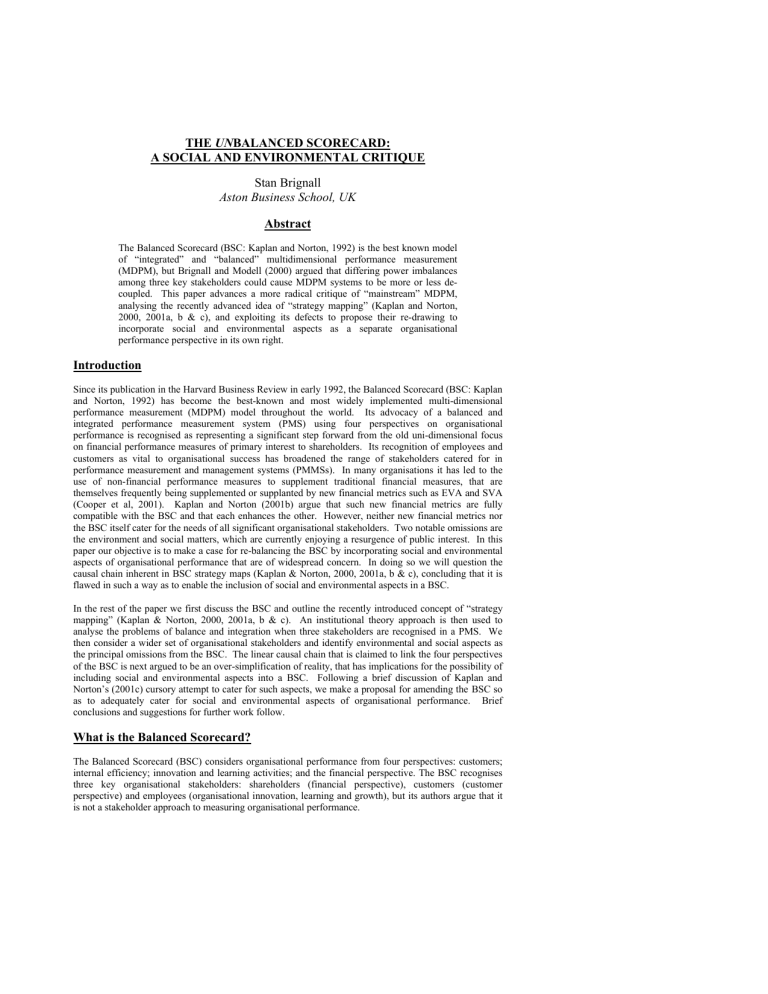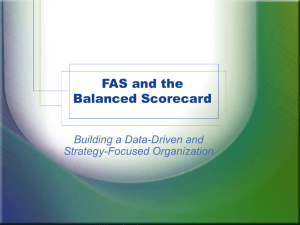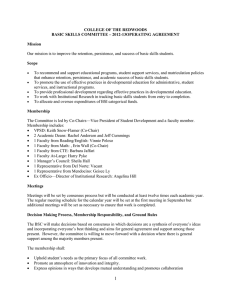160 - Brignal - The Unbalanced Scorecard

THE
UN
BALANCED SCORECARD:
A SOCIAL AND ENVIRONMENTAL CRITIQUE
Stan Brignall
Aston Business School, UK
Abstract
The Balanced Scorecard (BSC: Kaplan and Norton, 1992) is the best known model of “integrated” and “balanced” multidimensional performance measurement
(MDPM), but Brignall and Modell (2000) argued that differing power imbalances among three key stakeholders could cause MDPM systems to be more or less decoupled. This paper advances a more radical critique of “mainstream” MDPM, analysing the recently advanced idea of “strategy mapping” (Kaplan and Norton,
2000, 2001a, b & c), and exploiting its defects to propose their re-drawing to incorporate social and environmental aspects as a separate organisational performance perspective in its own right.
Introduction
Since its publication in the Harvard Business Review in early 1992, the Balanced Scorecard (BSC: Kaplan and Norton, 1992) has become the best-known and most widely implemented multi-dimensional performance measurement (MDPM) model throughout the world. Its advocacy of a balanced and integrated performance measurement system (PMS) using four perspectives on organisational performance is recognised as representing a significant step forward from the old uni-dimensional focus on financial performance measures of primary interest to shareholders. Its recognition of employees and customers as vital to organisational success has broadened the range of stakeholders catered for in performance measurement and management systems (PMMSs). In many organisations it has led to the use of non-financial performance measures to supplement traditional financial measures, that are themselves frequently being supplemented or supplanted by new financial metrics such as EVA and SVA
(Cooper et al, 2001). Kaplan and Norton (2001b) argue that such new financial metrics are fully compatible with the BSC and that each enhances the other. However, neither new financial metrics nor the BSC itself cater for the needs of all significant organisational stakeholders. Two notable omissions are the environment and social matters, which are currently enjoying a resurgence of public interest. In this paper our objective is to make a case for re-balancing the BSC by incorporating social and environmental aspects of organisational performance that are of widespread concern. In doing so we will question the causal chain inherent in BSC strategy maps (Kaplan & Norton, 2000, 2001a, b & c), concluding that it is flawed in such a way as to enable the inclusion of social and environmental aspects in a BSC.
In the rest of the paper we first discuss the BSC and outline the recently introduced concept of “strategy mapping” (Kaplan & Norton, 2000, 2001a, b & c). An institutional theory approach is then used to analyse the problems of balance and integration when three stakeholders are recognised in a PMS. We then consider a wider set of organisational stakeholders and identify environmental and social aspects as the principal omissions from the BSC. The linear causal chain that is claimed to link the four perspectives of the BSC is next argued to be an over-simplification of reality, that has implications for the possibility of including social and environmental aspects into a BSC. Following a brief discussion of Kaplan and
Norton’s (2001c) cursory attempt to cater for such aspects, we make a proposal for amending the BSC so as to adequately cater for social and environmental aspects of organisational performance. Brief conclusions and suggestions for further work follow.
What is the Balanced Scorecard?
The Balanced Scorecard (BSC) considers organisational performance from four perspectives: customers; internal efficiency; innovation and learning activities; and the financial perspective. The BSC recognises three key organisational stakeholders: shareholders (financial perspective), customers (customer perspective) and employees (organisational innovation, learning and growth), but its authors argue that it is not a stakeholder approach to measuring organisational performance.
More recently, Kaplan and Norton (2000, 2001a, b & c) have introduced the concept of “strategy mapping”. In such strategy maps the “chains of cause and effect” linking actions across the learning and growth, internal efficiency and customer perspectives to financial results for shareholders are given visual form. This linear, one-way cause and effect chain is central to the recent advocacy by Kaplan and
Norton (2000, 2001a, b & c) of the use of the BSC as a tool of strategic performance management and organisational change.
The risk and consequences of de-coupling: an institutional perspective
Unfortunately the BSC literature has neglected the insights of institutional theory, which explicitly recognises the importance of relative bargaining power in determining whose interests will predominate in an organisation and the consequent effects on what aspects of performance are measured, reported and acted upon (Di Maggio and Powell, 1983). This has implications for balance and integration in PMSs, and hence for the possibility of successfully implementing the BSC.
Both balance and integration have several possible meanings in a PM context, but they are clearly separate but linked conceptual constructs. From an instrumental perspective, the link between them would seem to be that some degree of integration is thought necessary to secure a balanced approach to realising the differing interests of the various stakeholders. However, in a recent paper on PMM in the New Public
Sector, Brignall and Modell (2000) argue that imbalances of power and differing interests among these three key stakeholders may lead managers to de-couple such “balanced and integrated” PMSs. Brignall and Modell (2000) argue that integration is not a pre-requisite for balance and that de-coupling need not be a passive response to institutional pressures but may instead be interpreted as a rational managerial choice intended to maintain balance in the face of unequal stakeholder powers.
Brignall and Modell (2000) go on to argue that PMSs may be becoming institutionalised (ie. standardised and ritualised), with discernible isomorphic tendencies. This raises the implications of various modes of
PMS implementation, which may be linked to differing organisational (Tolbert, 1988) or national
(Hofstede, 1994) cultures. Are these systems implemented in a coercive and universal fashion, in a normative but optional fashion, or in a skin-deep manner intended only to deceive observers – a form of
“protective colouration”? (cf. Di Maggio and Powell, 1983) Outcomes are likely to vary depending on implementation mode and hence one may see various types of couplings between various perspectives of
PMSs. De-coupling will occur if a PMS is merely used for external legitimacy seeking, but if it is used by other stakeholders as well as senior managers some form of loose coupling will occur. Tight couplings will only occur if the PMS permeates all levels of management and has the kind of significant change impact its proponents claim. One may therefore hypothesise the following relationships between PMS implementation mode (cf. DiMaggio and Powell, 1983) and the resulting form of coupling:
• coercive isomorphism: tight coupling
• normative isomorphism: loose coupling
• protective isomorphism: de-coupling.
While relations among a company’s managers and its shareholders, customers and employees respectively are all subject to company, contract and employment law, as Owen et al (2001) argue, in practice the City is so powerful that the needs of shareholders will dominate. So, while managers may pay lip service to the idea of a balanced set of PMs meeting the needs of a range of stakeholders, in practice measures of financial results for shareholders will tend to dominate, as the limited research in this area confirms (Ittner and Larcker, 1998a, p.221). Thus in practice, financial measures for shareholders are frequently decoupled from non-financial measures of interest to other stakeholders.
A wider view of stakeholders
A more important criticism of the Balanced Scorecard and Strategy Maps, however, is that they neglect several other important stakeholders whose need for performance-related information is worthy of recognition. Whilst there are some overlaps among the interests of differing stakeholders, and hence one such stakeholder might be chosen as a rough proxy for the others, for some stakeholders’ interests there are no clear and adequate proxies.
Two key stakeholders whose needs are not proxied by at least one of the three key stakeholders identified above are the environment and social matters, whose needs may be subject to legislation or regulation. In their recent book, Kaplan and Norton (2001c) refer briefly to environmental, health and safety (EHS) aspects and argue that “When such regulatory and EHS considerations are vital for a successful strategy, companies include several objectives in a ‘good corporate citizen” strategic theme in the internal perspective.” (p.92) Kaplan and Norton believe that “Companies whose operations entail EHS risks need to comply with regulations in the communities where they operate. Beyond compliance, they may seek to achieve a reputation as a leader in EHS performance to enhance their ability to recruit and retain valuable employees, and to maintain and expand their physical presence in communities.” (ibid) In what follows we consider whether this managerialist proposition will lead to a balanced consideration of such aspects of organisational performance and later consider how their representation might be improved.
Incorporating social and environmental aspects into the BSC
Gray et al (1995) argue that there are three theoretical contexts for social and environmental accounting research. The first relates to the “decision usefulness” of such information to decision makers, usually taken to be investors (Belkaoui, 1984; Aupperle, 1984). Mintzberg (1983) suggests that, while the results of such studies are inconclusive, there is evidence to suggest that it “pays to be good, but not too good.”
The second context concerns positive accounting theory and agency theory, which Gray et al (1995) dismiss as inimical to social and environmental aspects of organisational performance. This is because they are founded on notions of “free” markets and the supposed virtues of the “invisible hand”, hence are unconcerned with the market failures and social inequalities that campaigners are attempting to remedy.
The third category is social and political theory, in which Gray et al (1995) identify “stakeholder”,
“legitimacy” and “political economy” theories. Roberts (1992) argues that stakeholder theory provides a basis to “analyse the impact of prior economic performance, strategic posture towards social responsibility activities, and the intensity of stakeholder power on levels of corporate social disclosure.” Legitimacy theory argues that organisations must be seen to comply with regulatory requirements (see Kaplan and
Norton, 2001c, above) that many would see as part of the “social contract”. Mathews (1993, 1995) suggests that social contract theory is the most “persuasive moral argument in favor of increased social and environmental disclosures”. However, for the social contract to work, organisations must be held accountable for their actions, and Gray (1998) suggests that “the standpoints of accountability and transparency” are the most frequently used justifications for social and environmental disclosures. Gray
(1992) defines accountability as concerned with “the right to receive information and the duty to supply it.” However, Gray et al (1997) suggest that a stakeholder and accountability approach may fail, being
“too inert and only slowly responsive to changing stakeholder needs.” More seriously, it might be argued that the social and environmental literature considered so far is likely to be ineffective because it fails to sufficiently take into account the deep conflicts among different interests in society. Its is for this reason that we finally turn to Gray et al’s (1995) argument that social accounting can be seen to fall within political economy. The following quotation from Jackson (1982) is a useful definition:
“Political economy is the study of the interplay of power, the goals of power wielders and the productive exchange system (Zald, 1970, 233). As a framework, political economy does not concentrate exclusively on market exchanges. Rather it first of all analyses in whatever institutional framework they occur and, second, analyses the relationships between social institutions such as government, law and property rights, each fortified by power and the economy” (p.74)
Possibly the strongest critique of the mainstream social and environmental literature came from Tinker et al (1991). Tinker et al argue that the pragmatic approach of the mainstream neglects important issues of social justice and systematic social ills, so denigrating “the importance of accounting in shaping social struggles.” Their preference is for a “conflict based perspective” that places power asymmetries at the forefront of the analysis of the basic inequalities that cause the problems faced by modern societies.
This author argues that mainstream MDPM models such as the BSC are an important new form of organisational accounting with implications for political economy, that hitherto have been captured and controlled by managerialist interests. Furthermore, most of the research into their design, implementation and use has been managerialist in orientation, hence their affects on wider societal matters have been largely ignored. If this is so, then a consideration of the inclusion of social and environmental aspects of organisational performance in such MDPM models is particularly relevant at this time. However, a consultation document from the UKs Company Law Steering Group (1999) indicates that social (and environmental) concerns are unlikely to be reflected in impending revisions to UK Company Law. While
such matters may be handled differently elsewhere, in the UK, without legal backing, social and environmental aspects may never be reflected in managerial practice. This would be unfortunate, as a need to think about the environmental effects of current management actions that may not be felt until many years into the future may be a useful corrective to the short-termism endemic in the City and among managers. Nonetheless, a ray of hope may be detected from a consideration of the interrelationships among the four existing BSC perspectives, which analysis may be extended to include social and environmental aspects.
Cause and effect or interdependence?
The BSC and in particular its associated strategy maps essentially follow a one-way linear approach to strategic performance management, starting with the learning and growth perspective and culminating in financial results (or outcomes) for shareholders: effective innovation, learning & growth by employees à efficient internal business processes à satisfied
& loyal customers
à
good financial results for shareholders
Thus the BSCs “causal chain” contains financial outcome measures and their performance drivers, linked together in assumed cause and effect relationships. However, as Norreklit (2000) argues, “…there is no causal relationship between measures from the four perspectives. Instead, the arguments indicate that the perspectives are interdependent.” (p.75) Norreklit reaches this conclusion by proposing that the relationship between two variables cannot be both logical and causal, as a causal relationship can only exist if both variables are logically independent. In Norreklit’s opinion, Kaplan and Norton are confusing logical relationships with causal ones. In what follows we build on the work of Norreklit by showing that similar problems are inherent in some other MDPM models and that these problems create an opportunity to introduce social and environmental measures into the BSC and other models.
The Performance Pyramid of Lynch and Cross (1991) identifies different aspects of performance as being monitored at different organisational levels, with resulting information flows both up and down and across the levels. Lynch and Cross (1991), like Kaplan and Norton (1992), also assume a one-direction causal chain linking the various performance aspects at different levels. At the lowest level, good quality and delivery lead to customer satisfaction in the level above; delivery and cycle time affect flexibility; and productivity is determined by cycle time and waste. In a similar fashion at the next level up, customer satisfaction and flexibility will determine market results like market share; and flexibility and productivity will determine financial results such as ROI. Lynch and Cross make the normative proposal that measures of market and financial results should be discussed among senior SBU managers and their corporate superiors, whereas the measures at lower levels that drive these results should be monitored within the
SBU. As well as vertical relationships within the pyramid, however, there are also horizontal relationships. For example, some aspects of “flexibility” may affect customer satisfaction and productivity, and “market” measures such as market share may drive financial results. But overall, we can see a “causal chain”-type argument similar to that in the BSC.
Similarly, the Results and Determinants Framework (Fitzgerald et al, 1991) identifies six dimensions (or perspectives) on performance, split between two which measure aspects of the results of implementing an
SBUs competitive strategy (financial and competitiveness measures) and four which determine those results. This is a system of leading and lagging performance indicators (with the determinants leading and the results lagging), just as is assumed in the BSC. However, while this is a useful conceptual distinction, it is a little too neat, as we shall argue below.
Using the RDF to illustrate our arguments, an example of how complicated the temporal links among different performance perspectives can be is to consider a situation where an organisation may have decided, perhaps in the light of a customer satisfaction survey, that one of the twelve factors of service quality identified in the RDF needs improvement. Let us further assume that to help effect the desired improvement a particular quality performance measure will be introduced to ascertain whether the improvement is attained. Suppose too that an investment in improved processes and staff training will be required. What might be the consequent sequence of events? The first effect after taking corrective action may be an increase in expenditure that will be reflected in increased costs and reduced profits – so we would have a financial result acting as a leading indicator. Suppose next that the expenditure on staff training and business processes has the desired effect, and that the relevant service quality factor improves. When the quality improvement is noticed by customers, customer satisfaction and hopefully
customer loyalty and sales should rise and hence market share (a competitiveness measure) too. Finally, as sales rise unit costs will fall and profits rise. Thus, the complete sequence has been from poor customer satisfaction feedback re service quality (that triggers action), to worsening financial result, to improved quality determinant, to rising customer satisfaction determinant, to increased competitiveness results, culminating in an improved financial result:
Financial result -> innovation determinant -> internal process outcome -> quality determinant -> customer satisfaction determinant -> competitiveness result -> financial result.
The above chain is logically plausible, but not inevitable, not least because the chain relationships hypothesised are not causal. In practice, there could be many such combinations at the level of each individual performance improvement initiative. Mistakes in implementation or the actions of competitors could frustrate management’s intentions and lead to unintended consequences. Note too the ambivalent, dual nature of the measures in the chain above. Customer satisfaction, for example, is an outcome of the improved quality determinant but a driver of the competitiveness result that follows. Likewise, the competitiveness outcome (an increase in market share) is a determinant of the financial result that succeeds it. Thus outcomes can drive outcomes and drivers drive drivers. There is no single, unique sequence of events, and each perspective may contain both drivers and outcome measures that may be related to more than one other perspective.
However, the foregoing analysis begs two questions. First, the dynamic effects of actions and interactions among competitors are not considered; rather, it would appear to be implicitly assumed by the authors of the BSC, the RDF and the Performance Pyramid that the focal firm is the sole actor. The presence of multiple actors implementing their own competitive strategies (to which the focal firm must respond) and who will respond – often in unforeseen ways – to the actions of the focal firm mean that it is often not possible to tell what the future holds. Second, what are the relevant levels of organisational analysis for studying such interactions among performance dimensions and their detailed measures? Ittner and
Larcker (1998b), in their analysis of whether customer satisfaction indicators may act as leading indicators of financial performance, “…examine the value relevance of customer satisfaction measures using customer, business-unit and firm-level data.” (p.2) We suspect that, as one moves upwards from customer-level to business unit to firm-level, the problems caused by the aggregation of multiple initiatives will make it more difficult to trace chains of cause and effect and to identify leading and lagging indicators. We further believe that even the relationships for individual strategic initiatives are not as straightforward as the authors of the BSC, the Performance Pyramid and the RDF appear to assume. In sum, the causal relationships that the BSC strategy maps claim to model are not always linear and oneway, but are commonly a fuzzy mess of interactions and interdependencies that inevitably fail to capture the unintended consequences that many performance improvement initiatives may have.
The empirical study of the interrelationships among different performance perspectives and their measures is still in its infancy. In their literature review on customer satisfaction, Ittner and Larcker (1998b, op cit) summarise previous empirical studies as providing “…mixed evidence on the relation between customer satisfaction indexes and financial performance, and….no support for claims that customer satisfaction measures provide incremental information to the stock market on the firm’s future financial prospects.”
(p.4) Similar weak results are also reported for studies looking at the links between quality measures and accounting or stock returns (Ittner and Larcker, 1998a, p.218). Using customer and business unit data, the results from Ittner and Larcker’s own (1998b) study of customer satisfaction measures found “…modest support for claims that customer satisfaction measures are leading indicators of customer purchase behaviour…, growth in the number of customers, and accounting performance (business-unit revenues, profit margins, and return on sales).” (op cit, p.32) However, they go on to point out five limitations to their analysis, and call for further research to probe the reasons for their “…differential results across industries” (p.33) and for “…research using a broader set of nonfinancial metrics…”. (ibid) We agree with this call for further research, while noting the problems inherent in such work as it requires access to internal company data. We would hypothesise that one explanatory variable for differences from industry to industry (or company to company, or SBU to SBU) might be differing power relationships among key organisational stakeholders, as argued earlier (cf. Brignall and Modell, 2000).
Can one justify the introduction of social and environmental aspects into
MDPM models like the BSC?
If MDPM models of the interrelationships among performance perspectives and their measures are “a fuzzy mess” of complex interdependencies rather than a one-way linear chain of cause and effect, should we add still more complexity? Paradoxically, it is because we can see that financial measures, for example, may sometimes be lagging, outcome measures and at other times leading indicators that it is possible to add another performance perspective to the BSC – as many companies have done in practice
(Johnson, 1998). The important point to note is that, once one accepts that the strategy maps’ linear, oneway causal chain ending in financial outcomes for shareholders is not universally valid, one no longer has to ask and answer the question, “where would one place a social and environmental perspective in the chain?” If SEA were introduced into a BSC, there would still be some cause and effect relationships among the various perspectives and their measures, but the population of all possible relationships among performance-related phenomena could not be represented by a universal, linear one-way chain. Indeed, drawing on Davis (1971), we could further argue that multiple phenomena may be co-related (or not); may co-exist (or not); may co-vary positively or negatively (or not), whether incrementally or discretely; may be similar or opposite phenomena; and (finally) may be independent or dependent phenomena in a causal relationship. We argue that many of these interrelationships are possible among the performance variables and their measures in the four perspectives of a BSC. Therefore, pace Norreklit (2000), it is reasonable to conclude that many performance variables may not be interdependent, still less causally or even logically related. This may help to explain the weak and conflicting results from tests of causal relations among claimed performance drivers and their outcomes reported in empirical research to date (Ittner and Larcker,
1998 a and b).
It seems that the relative positioning of all performance perspectives (including the original four BSC perspectives) will be fluid and indeterminate, changing from situation to situation. Crucially, therefore, the way in which strategy maps are drawn will need to change, whether a new perspective is added or not. As there is no universally valid chain of causal relationships among the perspectives, future strategy maps should be drawn in a circle, where the sequence of the perspectives is immaterial, so facilitating the visualisation of multiple modes of connection among the perspectives.
Whilst the incorporation of social and environmental performance measures would make an already complex situation more complex, this is not a valid reason for excluding them. Indeed, in this context it is helpful to note that even its authors admit that the BSCs four perspectives are not fixed (Kaplan & Norton,
1997) and could therefore be expanded to include social and environmental aspects. However, as Figge et al (2001) point out, one need not add an additional perspective: one might instead fully integrate SEA into all four existing perspectives, develop a separate SEA scorecard, or indeed take the minimalist approach advocated by Kaplan and Norton (2001c). Our preference is to add a fifth perspective, but however it is done it will add to the complex set of variables that managers have to juggle when trying to meet the needs of a range of stakeholders. The objective of such a re-balancing of the BSC would be to help facilitate the delivery of a balanced set of outcomes for customers, employees, shareholders and the social and environmental aspects of organisational life that are of widespread public concern. And if this may be seen as hopelessly idealistic, at least the floating of the idea may encourage further research in this area.
Conclusions and further research.
This paper has advanced three main criticisms of mainstream MDPM in general and of the BSC in particular. First we have used institutional theory to argue that many PMSs will not be balanced and integrated, but rather that some managers may rationally de-couple (ie. dis-integrate) their PMSs in order to maintain balance (cf. Brignall and Modell, 2000) among stakeholders of unequal power. Second, we have argued that the possible interrelationships among performance variables are not, pace Kaplan and
Norton (2000, 2001 a, b & c), confined to a universally valid one-way linear chain of cause and effect; nor, pace Norreklit (2000) a series of interdependencies. Following Davis (1971) we have argued rather that there are five classes of possible relationships, plus the possibility of no relationship at all. Third, we have critically reviewed the social and environmental accounting literature and concluded that such aspects of organisational performance are a major omission from mainstream MDPM models such as the
BSC that should be included therein, preferably as an additional performance dimension in their own right.
We have argued that social and environmental aspects (SEA) are worthy of inclusion in the BSC (and other MDPM models) from a critical perspective. However, the likely effects of such an inclusion are difficult to determine for at least three reasons. First, from an institutional perspective, how much power and legitimacy will this aspect have in the face of powerful institutional shareholders whose rights are enshrined in company law? Second, the relative degree of influence of each of the three key stakeholders in most organisations (shareholders, customers and employees) will vary from company to company and over time (cf. Brignall and Modell, 2000), as will their respective attitudes to SEA. Third, in order for environmental and social objectives to be realised, managers will have to understand the interrelationships among not only the BSCs existing perspectives but also their interrelationships with measures relevant to the new, fourth stakeholder, SEA. Such an understanding will require a more sophisticated approach than the linear, one-way causal chain approach of previous BSC Strategy Maps.
The research agenda that flows from the above may be split into three. First there is research in the mainstream of MDPM, building on the criticisms of the assumed cause and effect relationships inherent in the BSC and other MDPM models. The objective here is better empirical estimates of the relationships among different performance variables, where any such relationships exist. Second, there is a need for research into the effects of differing institutional power imbalances on the operation and use of MDPM systems, building on earlier work (Brignall and Modell, 2000; Modell, 2001), but expanding it to include a fourth stakeholder. The three hypotheses above concerning institutional isomorphism are but a start here.
Third, there is more radical research into the incorporation of SEA into MDPM models such as the BSC.
In exploring the first part of the agenda, the “complementarities” ideas of Milgrom and Roberts (1995) for the multivariate analysis of complex interrelationships among many variables seem relevant. Such analyses might be supplemented by cross-sectional and longitudinal case studies from a variety of epistemological viewpoints, which might also be suitable for exploring the other two parts of the research agenda.
References
Aupperle K.E. (1984). “An empirical measure of corporate social orientation”, Research in Corporate
Social Performance and Policy, Vol.6, pp.27-54.
Belkaoui A. (1984). Socio-economic Accounting, Quorom Books, Connecticut
Brignall T.J. & Modell S. (2000). “An institutional perspective on performance measurement & management in the New Public Sector”, Management Accounting Research, September, Vol.11, pp.281-306
Cooper S., Crowther D., Davies M. and Davis E.W. (2001). Shareholder or Stakeholder Value, London:
CIMA
Davis M. (1971). “That’s Interesting ! Towards a Phenomenology of Sociology and a Sociology of
Phenomenology”, Philosophy of the Social Sciences, 1, 309-344
DiMaggio, P.J. and Powell, W.W. (1983). “The Iron Cage Revisited: Institutional Isomorphism in
Organizational Fields”, American Sociological Review, 48, 147-160.
Figge F., Hahn T., Schaltegger S. and Wagner M. (2001). “The sustainability balanced scorecard”, paper presented at the 2001 Eco-management and Auditing Conference, Nijmegen School of
Management, the Netherlands, 21-22 June.
Fitzgerald L., Johnston R., Brignall T.J., Silvestro R. and Voss C. (1991). Performance Measurement in
Service Businesses, London: C.I.M.A.
Gray R. (1992). “Accounting and environmentalism: an exploration of the challenge of accounting for accountability, transparency and sustainability”, Accounting, Organizations and Society, Vol.17,
No.3, pp.399-425.
Gray R. (1998). “Imagination, a bowl of petunias and Social Accounting”, Critical Perspectives on
Accounting, 9, pp.205-216.
Gray R., Kouhy R. and Lavers S. (1995). “Corporate social and environmental reporting: a review of the literature and a longitudinal study of UK disclosure”, Accounting, Auditing and Accountability
Journal, 8 (2), pp.
Gray R., Dey C., Owen D., Evans R. and Zadek S. (1997). “Struggling with the praxis of social accounting: Stakeholders accountability, audits and procedures”, Accounting, Auditing and
Accountability Journal, 10 (3), pp.325-364.
Hofstede G. (1994). “The business of international business is culture”, International Business Review,
Vol.3, No.1, 1-14.
Johnson S..D. (1998). “Identification and Selection of Environmental Performance Indicators:
Application of the Balanced Scorecard Approach”, Corporate Environmental Strategy, Vol.5, No.4,
Summer, pp.34-41.
Ittner, C.D. and Larcker, D.F. (1998a) Innovations in Performance Measurement: Trends and Research
Implications, Journal of Management Accounting Research, 10, 205-238.
Ittner, C.D. and Larcker, D.F. (1998b) “Are nonfinancial measures leading indicators of financial performance? An analysis of customer satisfaction”, Journal of Accounting Research, Vol.36
Supplement, 1-35.
Jackson P.M. (1982). The Political Economy of Bureaucracy, Philip Allan, Oxford.
Kaplan R.S. and D.P., Norton (1992). 'The Balanced Scorecard - Measures that Drive Performance”,
Harvard Business Review, January-February, pp. 71-79.
Kaplan R.S and Norton D.P. (1997), “Why does business need a balanced scorecard?”, Journal of Cost
Management, May-June, pp. 5-10
Kaplan R.S. and Norton D.P. (2000). “Having trouble with your strategy? Then map it”, Harvard
Business Review, September-October, pp.167-176
Kaplan R.S. and Norton D.P. (2001a). “Transforming the Balanced Scorecard from Performance
Measurement to Strategic Management: Part 1”, Accounting Horizons, Vol.15, No.1, March, pp.87-104
Kaplan R.S. and Norton D.P. (2001b). “Transforming the Balanced Scorecard from Performance
Measurement to Strategic Management: Part 1”, Accounting Horizons, Vol.15, No.2, June, pp.147-
160
Kaplan R.S. and Norton D.P. (2001c). The Strategy-Focused Organization, Harvard Business School
Press
Lynch R.L. and Cross K.F. (1991). Measure Up! Yardsticks for Continuous Improvement, Basil
Blackwell (2nd edition published 1995).
Mathews M.R. (1993). Socially Responsible Accounting, Chapman and Hall, London.
Mathews M.R. (1995). “Social and Environmental Accounting: A Practical Demonstration of Ethical
Concern”, Journal of Business Ethics, 14 (8), pp.663-670.
Milgrom P. and Roberts J. (1995). “Complementarities and fit: Strategy, Structure and Organisational
Change in Manufacturing”, Journal of Accounting and Economics, l9 (2): l79-208.
Mintzberg H. (1983). “The Case for Corporate Social Responsibility”, The Journal of Business Strategy,
4 (2), pp.3-15.
Modell S. (2001). “Performance Measurement and Institutional Processes: A Study of Managerial
Responses to Public Sector Reform”, Management Accounting Research, 12, 437-464.
Norreklit H. (2000). “The balance on the balanced scorecard – a critical analysis of some of its assumptions”, Management Accounting Research, 11, 65-88.
Owen D., Swift T. and Hunt K. (2001). “Questioning the role of stakeholder engagement in social and ethical accounting, auditing and reporting”, Accounting Forum, Vol.25, No.3, 264-282
Roberts R.W. (1992). “Determinants of Corporate Social Responsibility Disclosure: An Application of
Stakeholder Theory”, Accounting, Organizations and Society, Vol.17, No.6, pp.595-612.
Tinker A.M., Lehman C. and Neimark M. (1991). “Corporate social reporting: falling down the hole in the middle of the road”, Accounting, Auditing and Accountability Journal, 4 (1), pp. 28-54.
Tolbert P.S. (1988). “Institutional sources of organizational culture in major law firms” in Zucker L.G.
(ed), Institutional Patterns and Organizations: Culture and Environment, Cambridge MA, Ballinger.
Zald M.N. (1970). Power in Organizations, Vanderbilt University Press.





